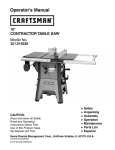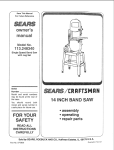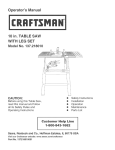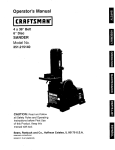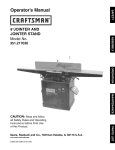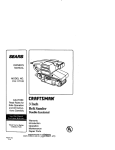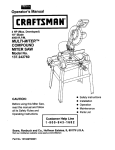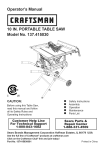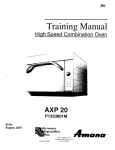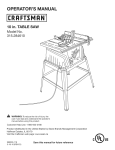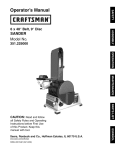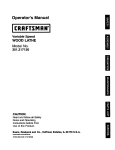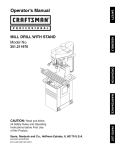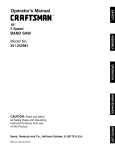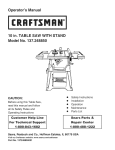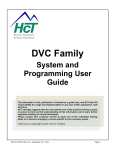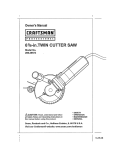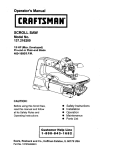Download Craftsman 21833 - Professional Contractor Table Saw Operator`s manual
Transcript
Operator's Manual CRAFTSMAN 10" CONTRACTOR TABLE SAW Model No. 351.218330 CAUTION: Read and follow all Safety Rules and Operating Instructions before First Use of this Product. Keep this Manual with Tool. Sears, Roebuck and Co., Hoffman www, sears.com/craftsman 31105,00 Draft (07/01/09) Estates, IL 60179 U.S.A. Warranty ......................................... 2 Safety Rules .................................... Unpacking Assembly 5 ...................................... 6-8 Installation ...................................... 8-9 Operation ..................................... 9-13 .................................... Repair Protection Agreement Wear safety shoes with non-slip soles. ° Wear safety glasses complying with United States ANSI Z87.1. Everyday glasses have only impact resistant lenses. They are NOT safety glasses. ° Wear face mask or dust mask if operation is dusty. • Be alert and think clearly. Never operate power tools when tired, intoxicated or when taking medications that cause drowsiness. 13 ....................... PREPARE WORK AREA FOR JOB 14 Troubleshooting ............................... Parts Illustration and List ........................ 16-17 18-29 Espafiol ...................................... 30-47 • Keep work area clean. Cluttered work areas invite accidents. • Do not use power toolsin dangerous environments. Do not use powertools in damp or wet locations.Do not expose power toolsto rain. Work area should be properlylighted. Keepvisitorsat a safe distancefrom work area. • ° ONE-YEAR FULL WARRANTY ON CRAFTSMAN TOOL • if this Craftsman toolfails due to a defect in material or workmanshipwithinone year from the date of pumhase,call 1-800-4-MY-HOME®TO ARRANGE FOR FREE REPAIR (or replacementif repairprovesimpossible). This warrantydoes not coverthe blade, whichis an expendable part. • Keep childrenout of workplace.Make workshopchildproof. Use padlocks,master switchesor removeswitch keysto prevent any unintentionaluse of powertools. Keep power cordsfrom comingin contactwith sharp objects,oil, grease and hot surfaces. TOOL SHOULD BE MAINTAINED (fthis toolis everusedfor commercialor rentalpurposes,this warrantywill applyfor only90 daysfrom the date of purchase. This warrantygivesyou specific legal rightsand you may also have other rightswhichvary from state to state. Sears, Roebuck and Co., Hoffman Estates, IL 60179 WARNING: For your own safety, read allof the instructions and precautions before operating tool. PROPOSITION 65 WARNING: Some dust created by power sanding, sawing, grinding, drilling and other construction activities contains chemicals known to the state of California to cause cancer, birth defects or other reproductive harm. Some examples of these chemicals Wear protective hair covering to contain long hair. ° 2-5 ....................................... Maintenance • • • Always unplugtoolpriorto inspection. Consult manual for specificmaintainingand adjusting procedures. • Keep tool lubricated and clean for safest operation. ° Remove adjusting tools. Form habit of checking to see that adjusting tools are removed before switching machine on. • Keep all parts in working order. Check to determine that the guard or other parts will operate properly and perform their intended function. ° Check for damaged parts. Check for alignment of moving parts, binding, breakage, mounting and any other condition that may affect a tool's operation. • A guard or other part that is damaged should be properly repaired or replaced. Do not perform makeshift repairs. (Use parts list provided to order replacement parts.) • • Maintain proper adjustment of rip fence and blade guard. Never adjust saw while running. Disconnect power to avoid accidental start-up. are: • Lead from lead-based paints. ° Have damaged or worn power cords replaced immediately. • Crystalline silica from bricks and cement and other masonry products. ° Keep blade sharp for efficient and safest operation. • Arsenic and chromium from chemically-treated KNOW lumber. • Your risk from these exposures vary, depending on how often you do this type of work. To reduce your exposure to these chemicals: work in a well ventilated area and work with HOW TO USE TOOL Use right tool for job. Do not force tool or attachment a job for which it was not designed. to do • Disconnect tool when changing blade. approved safety equipment. Always wear OSHNNIOSH approved, properly fitting face mask or respirator when using such tools. • Avoid accidental start-up. Make sure that the tool is in the "off" position before plugging in, turning on safety disconnect or activating breakers. CAUTION: Always ° Do not force tool. It will work most efficiently at the rate for which it was designed. • Keep hands away from blade and moving parts and cutting surfaces. ° Never leave tool running unattended. Turn the power off and do not leave tool until it comes to a complete stop. • Do not overreach. Keep proper footing and balance. ° Never stand on tool. Serious injury could occur if tool is tipped or if blade is unintentionally contacted. follow proper operating procedures as defined in this manual -- even if you are familiar with use of this or similar tools. Remember that being careless for even a fraction of a second can result in severe personal injury'. BE PREPARED FOR JOB • Wear proper apparel. Do not wear loose clothing, gloves, neckties,rings, braceletsor otherjewelrywhichmay get caught in movingparts of machine. © Sears, Roebuck and Co. 2 • Know your tool. Learn the tool's operation, application and specific limitations. ° • Handle workpiece correctly. Press firmly against table. Protect hands from possible injury. Use extra caution when the guard assembly is removed for resawing, dadoing, or rabbeting--replace guard as soon as that operation is completed. • • Turn machine off if it jams. Blade jams when it digs too deeply into workpiece. (Motor force keeps it stuck in the work.) Never turn the saw ON before clearing the table of all tools, wood scraps, etc., except the workpiece and related feed or support devices for the operation planned. • Never place your face or body in line with the cutting tool. • Feed work into the blade only as recommended "Operation" • Never place your fingers or hands in path of saw blade or other cutting tool. • For rip or rip-type cuts, the following end of a workpiece to which a push stick or push board is applied must be square (perpendicular to the fence) in order that feed pressure applied to the workpiece by the push stick or block does not cause the workpiece to come away from the fence, and possibly cause a kickback. • During rip and rip-type cuts, workpiece must be herd down on table and against fence with a push stick, push block, or featherboards, as applicable (see Figures l a and lb, page 4). in WARNING: For your own safety, do not operate your saw until it is completely assembled and installed according to instructions. STABILITY OF SAW If there is any tendencyfor the saw to tip over or move during certain cuttingoperations,such as cuttingextremelyheavy panels or long heavy boards, the saw shouldbe bolteddown. If you attach any kind of extensionsover 24" wide to either end of the saw, make sure you either bolt the saw to the floor, as appropriate, or support the outerend ofthe extension from the benchor floor, as appropriate. The push stick and push block examples shown below are useful for keeping hands and fingers away from saw blade during ripping, rabbeting and dadoing. Apply downward pressure and push workpiece through the cut and past the blades. Several other configurations may be suitable for safe operation. LOCATION The saw should be positioned so neither the operator nor a casual observer is forced to stand in line with the saw blade. Featherboards are used to keep the work in contact with the rip fence or table during the cutting operation. Use of featherboards can help to prevent kickbacks and binding. Featherboards should be used for all "non thru-sawing" operations. KICKBACKS A kickback occurs during a rip-type operation when a part or all of workpiece is thrown back violently toward operator. Keep your face and body to one side of the saw blade, out of line with a possible kickback. • Never reach in back of the cutting tool with either hand to hold down or support the workpiece, remove wood scraps, or for any other reason. Avoid awkward operations and hand positions where a sudden slip could cause fingers or hand to move into a saw blade or other cutting tool. Kickbacks and possible injury from them can usually be avoided by: • Maintaining rip fence parallel to saw blade. • Keeping saw blade sharp. Replace or sharpen anti-kickback pawls when points become dull. • Do not perform layout, assembly, or setup work on the table while the cutting tool is rotating. • Keeping saw blade guard, spreader, and anti-kickback pawls in place and operating properly. The spreader must be in alignment with the saw blade and the pawls must stop a kickback once it has started. Check their action before ripping. • Do not perform any operation freehand--always use either rip fence or miter gauge to position and guide the work. • Never use the rip fence when cross-cutting or the miter gauge when ripping. Do not use rip fence as a length stop. Never hold onto or touch free-end of workpiece or a free-piece that is cut off, while power is ON and/or saw blade is rotating. • Shut the saw OFF and disconnect power source when removing the table insert, changing the cutting too], removing or replacing the blade guard, or making adjustments. ° Not ripping work that is twisted or warped or does not have a straight edge to guide along the rip fence. • Not releasing work until you have pushed it all the way past the saw blade. • Using a push stick for ripping widths less than 6 inches. ° Not confining the cutoff piece when ripping or crosscutting. Provide adequate support to the rear and sides of the saw table for wide or long workpieces. PROTECTION: EYES, HANDS, FACE, BODY, EARS • If any part of your saw is missing, malfunctioning, or has been damaged or broken (such as the motor switch, electronic controls, other operating control, a safety device or power cord), cease operating immediately until the particular part is properly repaired or replaced. • Wear safety goggles that comply with United States ANSI Z87.1 and a face shield or dust mask if operation is dusty. Wear ear plugs or muffs during extended periods of operation. Small loose pieces of wood or other objects that contact the rear of the revolving blade can be thrown back at the operator at excessive speed. This can usually be avoided by keeping the guard and spreader in place for all thrusawing operations (sawing entirely thru work) and by removing all loose pieces from the table with a long stick of wood immediately after they are cut off. 3 ib Plastic and composition materials (like hardboard) may be cut on your saw. However, since these are usually quite hard and slippery, the anti-kickback pawls may not stop a kickback. Therefore, be especially attentive to following proper setup and cutting procedures for ripping. Do not stand, or permit anyone else to stand, in line with a potential kickback. • If you stall or jam the saw blade in the workpiece, turn saw OFF and remove the workpiece from the saw blade. Check to see if the saw blade is parallel to the miter gauge grooves and if the spreader is in proper alignment with the saw blade. If ripping at the time, check to see if the rip fence is parallel with the saw blade. Readjust as required. • Do not remove small pieces of cutoff material that may become trapped inside the blade guard while the saw is running. This could endanger your hands or cause kickback. Turn saw OFF and wait until blade stops. Use extra care when ripping wood with twisted grain or wood that is twisted or bowed--it may rock on table and pinch saw blade. 4 It 5" Long (typ.) Solid Lumber %+" (typ.) J "_•_,;,,,, ,, + IIIIIll}[IlUHIIilIlUlI" I ¾,, J Clamp to rip fence or rip fence extension to keep work on the table. 12" - 1½" + t I Rip Fence 6½" I Table ,-- 13A,, Blade Miter slot i + 5 +1 !I_12" ' i I I ......... ,I + I I p to table to guide work Use featherboards in combinations as required to control workpieces. Figure lb - Featherboards USE ONLY ACCESSORIES • Crosscutting operations are worked more conveniently and with greater safety if an auxiliary wood facing is attached to miter gauge using holes provided. However, facing must not interfere with proper functioning of saw blade guard. ° Make sure the top of the arbor or cutting tool rotates toward you when standing in normal operating position. Also make sure the cutting tool, blade flange and arbor nut are installed properly. Keep the cutting tool as low as possible for the operation being performed. Keep all guards in place whenever possible. • Do not use any blade or other cutting tool marked for operating speed less than 4000 RPM. Never use a cutting tool larger in diameter than diameter for which saw was designed. For greatest safety and efficiency when ripping, use maximum diameter blade for which saw is designed, since under these conditions spreader is nearest the blade. 2 Figure la - Push Sticks and Push Blocks KNOW YOUR CUTTING TOOLS • Dull, gummy, improperly sharpened or set cutting tools can cause material to stick, jam, stall saw, or kickback at operator. Minimize potential injury by proper care and machine maintenance. WARNING: Never attempt to free a stalled saw blade without first turning saw OFE • Never use grinding wheels, abrasive cutoff wheels, friction wheels (metal slitting blades), wire wheels or buffing wheels. 4 DESIGNED FOR SAW • Adjust table inserts flush with table top. Never operate saw unless proper insert is installed. M8 x 20 Hex Head Bolt (4) M8 Lock Washer (20) • Never feed material into the cutting tool from the rear of the saw. An accident and serious injury could result. M8 Flat Washer (20) M8 Hex Nut (16) THINK SAFETY M8 Acorn Hex Nut (4) Safety is a combination of operator common sense and alertness at all times when the saw is being used. Never use another person as a substitute for a table extension, or as additional support for a workpiece that is longer or wider than basic saw table, or to assist in feeding, supporting or pulling the workpiece. Hardware Bag #3 M6 x 16 Pan Head Screw (2) Do not pull the workpiece through the saw blade--position your body at the infeed side of the guard; start and complete the cut from that same side. This will require added table support for long or wide workpieces that extend beyond the length or width of the saw table. MI0 x 25 Socket Head Bolt (4) M8 x 16 Socket Pan Head Screw (8) M6 Flat Washer (2) M6 Hex Nut (2) Hardware Bag #4 M6 x 12 Socket Pan Head Screw (24) M6 x 16 Socket Head Bolt (2) M5 x 12 Socket Head Bolt (4) M3 x 10 Pan Head Screw (4) CAUTION: Follow safety instructions that appear on the front of your saw. M10 Lock Washer (4) M6 Hex Nut (2) M5 Lock Washer (4) M3 Lock Washer (4) M10 Flat Washer (4) Refer to Figure 2. CAUTION: Do not attempt assembly if parts are missing. Use this manual to order replacement parts. Check for shipping damage or missing parts. If any parts are damaged or missing, calt 1-800-266-9079 for replacement. M6 Flat Washer (2) M5 Flat Washer (4) M3 Flat Washer (4) The table saw body comes assembled as one unit. Additional parts which need to be fastened to the saw should be located and accounted for before assembling: Hardware Bag #5 10/I3mm Open End Wrench 4mm Hex Wrench A B Extension Tab]e (2) Dust Chute 5mm Hex Wrench 8mm Hex Wrench C D Front Rail (2) Rear Rail (2) E F G Miter Gauge Assembly Blade Guard Assembly Dado Insert H Tab]e Insert I J K Handwheel Assembly with Knob (2) Rip Fence Assembly Rubber Foot (4) E _F L L Antkkickback Pawi Assembly M Line Cord Hooks (2) N Brace O Rip Fence Storage Hooks (2) P Q R Blade Guard Storage Hooks (2) Push Stick Storage Hooks (2) Push Stick S T Base Panel (4) Corner Support (4) U Caster Set (2) Q Hardware Bag #1 S M!0 x 25 Socket Head Bolt (6) M10 Lock Washer (6) M10 Flat Washer (6) a L._ Hardware Bag #2 Figure 2 - Unpacking M8 x 28 Hex Head Bolt (8) M8 x 25 Hex Head Bolt (8) 5 P IMPORTANT: Table is coated with a protectant. To ensure proper fit and operation, remove coating. Coating is easily removed with mild solvents, such as mineral spirits, and a soft cloth. Avoid getting solution on paint or any of the rubber or plastic parts. Solvents may deteriorate these finishes. Use soap and water on paint, plastic or rubber components. After cleaning, cover all exposed surfaces with a light coating of oil. Paste wax is recommended for table top. WARNING: Never use highly volatile solvents. Non flammable solvents are recommended to avoid possible fire hazard. ° Place the mobile base assembly onto the cabinet and dust chute and secure in position with four socket head bolts, lock washers and flat washers (Fig. 12, Key Nos. 10, 11 and 12). NOTE: The foot pedals of the caster sets face towards front and rear of cabinet, the push stick is attached to the left side of the base and rip fence hooks are on the right side of the base. • ° Press the four rubber feet (Fig. 12, Key No. 4) to the base legs. Turn the saw upright, reattach the back panel of the cabinet. HANDWHEEL Refer to Figures 3, 4, 5, 7, 8, 9 and 10. ASSEMBLY Refer to Figure 13, page 26. WARNING: Make certain that the saw is disconnected CAUTION: Do not attempt assembly if parts are missing. Use this manual to order replacement parts. from the power source. Be certain all parts are clean and free of shipping preservative. Also, completely remove all parts of packing. Saw cabinet should be directly on the floor. • SAW INSTALLATION ° Positioning the saw on a level surface (shimming may be required) will improve stability and accuracy and prevent warpage and failure of cast components and welds. ° WARNING; Make certain that the saw is disconnected from the power source. Place one of the handwheels (Key No. 30) onto the blade raise/lower shaft (Key No. 56) located on the front of the cabinet. Align the groove in the back of the handwheel with the pin. Thread the locking knob (Key No. 27) onto the threaded end of the shaft. Repeat the steps above to assemble the remaining handwheel and locking knob onto the bevel shaft located on the right side of the cabinet. ATTACH LINE CORD HOOKS ASSEMBLE THE MOBILE BASE Refer to Figure 10, page 20. ° Tilt the table to 45°. Refer to Figure 12, page 24. NOTE: Finger tighten bolts and nuts until assembly of mobile base is complete. Then tighten all fasteners securely. • • ° ° Use two M8 x 16 socket pan head bolts (Key No. 1) to attach a corner support bracket (Key No. 3) to each fixed support (Key Nos. 9 and 29) at the ends of one of the caster sets. Repeat for the other caster set. Attach the front panel (Key No. 8 - stamped 'A') between the two corner supports attached to one of the caster sets using six M6 x I2 socket pan head bolts (Key No. 2). Note: Place the panel edges INSIDE the corner support surfaces. ASSEMBLE ASSEMBLE PUSH STICK STORAGE BRACKETS Attach the rear panel (Key No. 8) between the two corner supports attached to the remaining caster set. = Attach the left side panel (Key No. 25 - stamped 'B') to the assemblies made in the previous two steps. • Attach the right side panel (Key No. 33 - stamped 'C') to the assembly made in the previous step. Refer to Figure 12, page 24. Installthe push stickstorage brackets (KeyNo. 23) to the left side panel (Key No. 25) of the base usingfour screws, lock washers and flat washers (Key Nos. 20, 2t and 22). ASSEMBLE ASSEMBLE BASE TO CABINET Refer to Figures i0 and 12, pages 20 and 24. ° RIP FENCE STORAGE BRACKETS Refer to Figure 12, page 24. Install the rip fence storage brackets (Key No. 34) to the right side panel (Key No. 33) of the base using two screws, flat washers and hex nuts (Key Nos. 14, 31 and 32). NOTE: Saw cabinet and base are very heavy. Two people are required to assemble this saw. • ° BLADE GUARD STORAGE BRACKETS Refer to Figure 12, page 24. Installthe blade guard storage brackets (Key Nos. 18 and 19) to the leftside pane[ (Key No. 25) of the base usingfour screws, lock washers and fiat washers (Key Nos. 15, 16 and 17). • ° Install the line cord hooks(Key No. 9) using sockethead bolts, washersand nuts (Key Nos. 10, 12 and 13) to the leftside of the saw cabinet. Place a large sheet of cardboard or carpet on the floor to protect the table top. Carefully place the saw cabinet upside down on the floor. Remove the six bolts and the back panel (Fig. 10, Key Nos. 2 and 24). This will allow you to adjust the cabinet holes to align with the base holes. Place the dust chute (Fig. 12, Key No. 30) on the cabinet with the chute facing upwards. ATTACH EXTENSION TABLES Refer to Figure 11, page 22. 6 ° Assemble extension table (Key No. 35) to the table using hex head bolts, lock washers and fiat washers (Key Nos. 36, 37 and 38). ° Hand tighten only. Do not tighten completely until tables are level. ° Repeat above procedure for the other extension table. • Use a straight edge to check level and flatness between main and extension tables. • After tables are adjusted level and flat, secure the extension tables by tightening the hex nuts completely. RAIL ASSEMBLY Refer to Figure 11, page 22. ° Insert two M8 x 28 hex head bolts and two M8 x 25 hex head bolts into the T-slot of the right front guide rail (Key Nos. 16, 21, and 22) (The two longer bolts will attach to the table; the two shorter bolts attach to the table extension.) CHECK TABLE ALIGNMENT Refer to Figures 3 and 13, pages 7 and 26. • Saws are shipped from the factory with the table adjusted so the miter gauge slots are parallel to the saw blade. However, in order to obtain the best results from the saw, it is suggested this adjustment be checked before operating. ° A simple method of checking alignment is as follows: Bolt or clamp a dowel rod or similar object to miter gauge (a combination square can be substituted). Pick out a tooth on front of blade and set the dowel to it so it is just touching. Move same tooth to back of blade. • • NOTE: Hand tighten all hardware during rail assembly. Do not completely tighten hardware until all rails are mounted. Gauge this tooth with the dowel rod. If the tooth is in the same position, relative to the miter gauge, the table is parallel with the blade. In short, the miter gauge slots must be parallel with the blade. This means that when measuring distance between blade and slot at the front and rear of the blade, the distances will be equal (see Figure 3). • Attach the left front rail and both rear rails (Key Nos. 18, 32 and 34) in the same manner. • Position rails so that rails are butted together and the joint between rails is aligned with the blade. Secure all hardware completely. Use a straight edge to check level and flatness between right and left rail and make certain that both front rails are parallel to the table surface. • • • NOTE: Be positive to measure the distance or make the test on the same tooth of the saw blade in both front and rear positions. • • • If an adjustment is necessary, proceed as follows: (Refer to Figure 13). Loosen the hex head bolts and lock washers (Nos. 36, 37 and 38) of the trunnion. Shift trunnion until a position is found where the saw blade is parallel to the miter gauge slots. NOTE: Saw blade should also be centered within its table insert opening. , After front rails are adjusted level and flat, tighten the screws completely. Repeat above steps for rear rails. Attach the brace (Key No. 30) to the far right end of the rails using four hex head bolts, flat washers, lock washers and cap nuts (Key Nos. 26-29). ATTACH SWITCH ASSEMBLY Refer to Figure 11, page 22. • Rear r_Y Attach rail to the table and right table extension using flat washers, lock washers and hex nuts (Key Nos. 23, 24 and 25). Attach the switch assembly (Key Nos. 1-10) to the bottom of the left side of the front rail using two flat washers, lockwashers and hex head bolts. (Key Nos. 11, 12, 13 and 14). RIVING KNIFE ASSEMBLY __'1",j_, Refer to Figure 4, page 8. WARNING: Make certain that the saw is disconnected from the power source. : _aw _Blade : t I 1 Ii • • Ii I i Ii 1 1 Ii Ii • • Riving knife must be in line with blade. Make sure riving knife sits flat against mounting bracket and lock plate. RIVING KNIFE TO BLADE ADJUSTMENT Refer to Figure 4, page 8. Front • "'Miter Gauge Slots ''f Figure 3 - Aligning Miter Slots to Blade • ° Riving knife is installed on the saw. Raise the blade completely to access the riving knife. Loosen the locking knob and raise the riving knife to its highest position. Riving knife has three holes for three positions. The highest position is for all thru cuts. The middle position is for rabbets and other non-thru cuts, (with guard and pawls removed). The lowest position is for dado cuts. Make sure locking pin is aligned with riving knife hole and secure in position by tightening locking knob. Tighten the hex head bolts and lock washers very securely. This procedure will set the table and blade in parallel position and prevent the trunnion from shifting. Riving knifeto blade cJearance:the gap between the riving knife and the saw blade should be an even distance across the entire radius. The rivingknifeshouldalso be in line with the saw blade, if adjustmentis necessary: 1. Locatethe riving knife bracket. 2. Loosenthe two sockethead cap screws slightlyenough to move the bracketbringing the rivingknife in linewith the saw blade makingsure the gap between the blade and knifeis even and from ¼to _," in distance, 3. Once the riving knife is alignedwiththe blade, tighten the socket head cap screws. 7 RIP FENCE ASSEMBLY INSTALLATION Refer to Figure 9, page 18. ° Positionrip fence assembly at end of saw. Be certainlocking lever (Key No.2) is in UP unlockedposition. ° Place rip fence assembly onto rails,positioningclamp (No. 26) over rear rail and then placingripfence ontofront guide rail. ° Rip fence should now ride freely on rip fence rails. Once rip fence is completely installed, it should be thoroughly adjusted. (See Operation, page 11, Rip Fence Adjustment.) Locking Pin INSTALL MITER GAUGE Refer to Figure 14, page 28. ° Figure 4 - Riving Knife ° INSTALL TABLE INSERT Refer to Figure 11, page 22. ° Place table insert (Key No. 41) into throat of table. • Insert is held in position by magnet in table. • To adjust insert level with table, adjust leveling screws (Key No. 42) up or down. ATTACH BLADE GUARD AND ANTI-KICKBACK PAWLS Placethe slot of blade guard body (Key No. 11) over the riving knife.Throughbolt of guard is placed in the notch indicatedin Figure5. • Positionguard completelydownon rivingknifeand press latch (Key No. 16) to lock in position. ° Bladeguard body should be parallel to the table.Use set screws(Key No. 8) to adjustif needed. • Place anti-kickbackpawl set onto rivingknifeat notches indicated.The springpin is placedin the front notchand bolt is placed in the rear notch. ° Press pawl set completelydown and press latchto secure in position. ELECTRICAL CONNECTIONS GROUNDING INSTRUCTIONS WARNING: improperconnectionof equipmentgrounding conductorcan resultin the riskofelectricalshock.Equipmentshould be grounded whilein usetoprotectoperatorfrom electricalshock. • Check with a qualifiedelectrician if groundinginstructions are not understoodor if in doubtas to whetherthe tool is properlygrounded. • Thistool isequippedwith an approved3-conductorcord rated at 300V and a 3-pronggroundingtypeplug(see Figure 6) for yourprotectionagainst shock hazards. Refer to Figures 5 and 14, page 28. • • Grounding plug should be pluggeddirectlyintoa properly installedand grounded3-prong grounding-typereceptacle, as shown (Figure6). Properly Grounded Outlet NOTE: The teeth of anti-kickback pawls should touchtable surface. Use set screws (Key No. 17) to adjust if needed. iBlade Guard The mitergauge comespreassembled.Unpackthe miter gauge and clean thoroughly.Be certain mitergauge T-slotsin table are also thoroughlycleaned. The mitergauge is guidedthroughthe T-slotwith a roller guide at the frontof guidebar. To insertmiter gauge, first insert rollerguideintoT-slotat front of table. Grounding Pawl Set Prong 3-Prong Plug ___ Figure 6 - 3-Prong Receptacle ° Do not remove or alter grounding prong in any manner. In the event of a malfunction or breakdown, grounding provides a path of least resistance for electrical shock. WARNING: Do not permit fingers to touch the terminals of plug when installing or removing from outlet. 8 • Plug must be plugged into matching outlet that is properly installed and grounded in accordance with all local codes and ordinances. Do not modify plug provided. If it will not fit in outlet, have proper outlet installed by a qualified electrician. ° Inspect tool cords periodically and if damaged, have them repaired by an authorized service facility. • Green (or green and yellow) conductor in cord is the grounding wire. If repair or replacement of the electric cord or plug is necessary, do not connect the green (or green and yellow) wire to a live terminal. Where a 2-prong wall receptacle is encountered, it must be replaced with a properly grounded 3-prong receptacle installed in accordance with National Electric Code and local codes and ordinances. WARNING: electrician. 240 VOLT OPERATION ° To use the saw with a 240V, single-phase power supply, have a qualified electrician attach a 240 volt, 15A 3-prong plug onto saw line cord and install the proper connectors and receptacles to power supply. • See wiring diagram (Figure 8) for wiring instructions. This work should be performed by a qualified A temporary 3-prong to 2-prong grounding adapter (see Figure 7) is available for connecting plugs to a two pole outlet if it is properly grounded. Grounding Lug Adapter 3-Prong Plug ° ° Make Sure This Is Connected To ° ) 1 ) (. 4 ) (.. 3 ( 1 • Use the table to determine the minimum wire size (A.W.G.) extension cord. ° Use only 3-wire extension cords having 3-prong grounding type plugs and 3-pole receptacles which accept the tool plug. • If the extension cord is worn, cut, or damaged in any way, replace it immediately. L2 ( 240V 2 ) 4 ) L2 DESCRIPTION The Craftsman 10" Model Number 218330 contractor saw offers precise cutting performance for all woods up to 3_" thick. The saw is designed for the professional user and is ruggedly constructed for continuous service. The 10" Saw is recommended for use with a 10" blade. The use of any extension cord will cause some drop in voltage and loss of power. Wires of the extension cord must be of sufficient size to carry the current and maintain adequate voltage. ) L Refer to Figures 9-14, pages 18-28. CORDS ° 1 120V I Figure 8 -Wiring Schematic Many cover plate screws, water pipes and outlet boxes are not properly grounded. To ensure proper ground, grounding means must be tested by a qualified electrician. The saw features an extra large cast iron table. Saw body has on board storage for push stick, miter gauge, rip fence and saw blades. Saw is equipped with a riving knife and a clear acrylic blade guard with anti-kickback feature. Cabinet is constructed of heavy gauge welded steel, totally enclosed and is ported for a 4" vacuum hose. Rip Fence Assembly features a heavy-duty precision rip fence that is designed for simple and one-hand maneuverability. Front rail is calibrated in inches and millimeters with a magnified window for close tolerances. SPECIFICATIONS Cord Length (120V Operation) Wire Size A.W.G. Up to 25 ff....................................... 14 Up to 50 ft....................................... 12 Capacity with 10" Blade: Depth of cut at 90 °. .............................. Maximum tilt angle of arbor (left) .................... Depth of cut at 45 ° . ............................. NOTE: Using extension cords over 50 ft. long is not recommended. ELECTRICAL 2 kl (A 3-prong to 2-prong grounding adapter is not permitted in Canada.) Where permitted, the rigid green tab or terminal on the side of the adapter must be securely connected to a permanent electrical ground such as a properly grounded water pipe, a properly grounded outlet box or a properly grounded wire system. Extension ( L1 A Known Ground Do not use a 3-prong to 2-prong grounding adapter unless permitted by local and national codes and ordinances. EXTENSION ) I 2-Prong Receptacle Figure 7 - 2-Prong Receptacle with Adapter ° 3 Max. cut right of blade with rip fence ................. Max. cut left of blade with rip fence .................. CONNECTIONS WARNING: Make sure unit is off and disconnected power source before inspecting any wiring. from 3'_" 45 ° 2¾," 30" 13" Saw Dimensions: The saw is prewired for use on a 120 volt, 60HZ power supply. The power lines are inserted directly onto the switch. The green ground line must remain securely fastened to the frame to properly protect against electrical shock. Table height ................................... 37¾" Cabinet depth ................................... Cabinet width.................................. 22" 19Y2" Table area .............................. Front of table to blade ........................... 9 26'/, x 20_," 11¾" Rip Fence Dimensions: BLADE HEIGHT ADJUSTMENT Rip fence ..................................... 31¼" Refer to Figure 13, page 26. Rip fence rails (front and rear) ..................... 56_" * Blade height is controlled by handwheel the front of the saw. • To adjust height, loosen locking hand knob (Key No. 27). Rotate knob counterclockwise approximately three turns. Turn handwheel to desired blade height. Blade capacity maximum .......................... Blade arbor ..................................... 10" %" Dado blade capacity maximum ..................... ,¾g' Saw Constructions: CAUTION: For safety, blade should be raised only %" above the surface of the material to be cut. However, if hollow ground blades are used, raise blade to its maximum height to allow for greater blade clearance. Cabinet .................... Totallyenclosedsteel panel Table ..................................... Cast iron Ripfence ............................. Aluminum tube Drive system.................................. V-belt Exhaust port ................................ 4" Male Miter gauge .............. Cast ironwithT-slotroller guide Blade guard .............. Acrylic with anti-kickback pawls Switch ............... Lockingpaddle switch with overload Arbor R.RM......................... 3450 RPM approx. Motor:................. I_HP, 3550 RPM, capacitorstart, capacitor run, 120/240V, 15/7.5A, single-phase, ball bearing Gross weight with motor ....................... 308 lbs • BLADE TILT ADJUSTMENT Refer to Figure 13, page 26. ° The saw blade can be set at any angle between 90° and 45°. Blade tilt iscontrolledby the handwheel (Key No.30) on the rightside of the saw.The indicator (Key No. 86) on front of saw showsthe tilt angle of the blade. • To adjusttilt, loosen lockinghandknob(Key No. 27). Rotateknob counterclockwiseat leastthree turns.Turn handwhee]to desiredblade angle. Lockblade angle into position. ° Lockhandwhee](Key No. 30) by tighteninglockinghand knob (Key No. 27) clockwise.Tightenonly untilsnug. ° The saw is equipped with positivestops at 90° and 45 °. These positivestopsallow operatorto positionsaw blade at 90° and 45° quickly and accurately. WARNING: The operation of any power tool can result in foreign objects being thrown into the eyes, which can result in severe eye damage. Aiways wear safety goggles complying with United States ANSI Z87.1 before commencing power tool operation. 90 ° STOP ADJUSTMENT Refer to Figures 11 and 13, pages 22 and 26. ° Raise saw blade above table as far as possible.Set blade at 90° to table by turningthe tiltinghandwheel.Place a square on table and checkto see if blade is perpendicular to the table.When checkingput square flush against saw blade.Do not put square on teeth of saw blade. • If the bladewill not tilt to 90 °, turn (counterclockwise) the set screw(Fig. 11, Key No. 44) at the left front of the table insert untilthe blade can be positionedto 90°. ° Once the blade has been tiltedto 90° (confirm this using yoursquare), tightenthe bevel handwheellock knob, locatedon the side of the cabinet.This will keep the blade from tiltingfurther. STARTING AND STOPPING THE SAW Refer to Figure 11, page 22. WARNING: Never operatesaw withoutblade guardsin place.Be sure blade is not in contactwith workpiecewhen motor is started.Start motorand allow saw to cometo full speed. WARNING: Make sure the electricalcharacteristicsof motor nameplateand powersource are the same. • The ON/OFF switch is locatedunder the front railof the table saw at the left side. • ° • Lock blade height into position. Lock handwhee] (Key No. 30) by tightening locking knob (Key No. 27) clockwise. Tighten only until snug. IMPORTANT: Do not over tighten. Only a small amount of pressure is necessary to lock handwheel securely. WARNING: Disconnect power before attempting any of the following procedures. Be certain switch is in OFF position and safety disconnect (or breaker) is in OFF or open position. Saw blade must not be moving. Saw blade will rotate freely after motor is turned off. Allow blade to come to a complete stop before attempting any of the following procedures. • (Key No. 30) on To turnsaw on, stand to either side of the bladewnever in line with it. Pull up switch (Key No. 2). Always allowsaw blade to come up to fult speed beforecutting. Do not turnmotor switch ON and OFF rapidly.This action overheatsthe motorand may cause saw blade to loosen. ° Turn the set screw (clockwise)until it comes in contact withthe positivestop. • Check tilt indicatorpointer,if necessary, adjust pointerso it points to 0° mark on scale. To adjustpointer,remove handwheeland loosenscrew (Fig. 13, Key No. 84). Be sure to tightenscrew securely after adjustmentis completed. Never leave saw while the poweris on. To turnthe table saw off, pressthe largered OFF paddle (KeyNo. I). Never leave saw until cuttingtoolhas come to a completestop. WARNING: Foryour own safety, lowerblade or cuttingtool below table surface. If blade istilted, return it to verticalposition.Turn offsafety disconnector circuitbreakerwhen saw is not in use. 45 ° STOP ADJUSTMENT Refer to Figure I1, page 22. • Tiltthe saw bladeto 45 °. Usinga combinationsquare, checkto see if blade is 45° to the table. ° 10 If the bladewill not tilt to 45 °, turn (counterclockwise) the set screw (Key No. 44) locatedat the rightof the table insert, untilthe blade can be positioned to 45°. • With the blade at 45 °, tighten the bevel handwheel knob to keep the blade from further tilting. • Turn the set screw clockwise until it comes in contact with the positive stop. SETTING CLAMPING lock PRESSURE Refer to Figure 9, page 18. TABLE INSERT ADJUSTMENT Rip fence has been adjusted at the factory to locksecurely when the lock handle is pusheddown. To adjust: * Unlockfence and remove it from the rails. Refer to Figure i1, page 22. ° ° • The table insert (Key No. 41) must always be level with the saw table. Place a straight edge across the front and rear of the table insert. Check that the insert is perfectly level with the saw table. ° To level the table insert, turn one or more adjusting set screws (Key No. 42) as needed and recheck. • The table insert is equipped with a finger hold for easy removal. Adjust the hex nut (Key No.31) untilthe fence is held securelywhen the lock handle ispushed down, SETTING FENCE PERPENDICULAR Refer to Figure 9, page 18. = Positionfence anywhereon table and lockit down. • Place a squareon the table nextto the fence and checkto see thatthe fence is at 90° to the table. ° MITER GAUGE ADJUSTMENT If an adjustmentis necessary,unlockthe fence and turn eitherof the two front adjustingscrews (Key No.13). NOTE: This is for micro-adjustment only.If fence cannot be adjustedsquare, recheck rail adjustment. • Miter gauge supplied with saw is equipped with individually adjustable index stops at 0° and 45 °, right and left, and can be manually adjusted up to 60 ° right and left. ° Adjustment to index stops can be made by loosening locking nut and tightening or loosening three adjusting screws. Be sure to tighten locking nut after adjustment is made. CURSOR ADJUSTMENT • Face of miter gauge has two holes for purpose of attaching auxiliary facing. ° Positionthe fence several inchesto the rightof the saw blade. • Miter gauge is accurately constructed for precision work. Miter gauge is guided through T-slot with a roller guide mounted at front of guide bar. Roger guide adds to miter gauge's stability and prevents the guide bar from leaving T-slot. • Lockthe fence down and measurethe exact distance betweenthe saw blade and the insideof the fence. Refer to Figure 9, page 18. ° Raise the saw blade above the table. ° Loosenthe two screws (Key No. i6) on the lens and slide it left or rightuntilthe cursor(red line)equalsthe measurement obtainedin the previousstep. ° Retightenthe screws and make a test cut. Measure the cut pieceto verifythat the cursoris set correctly. NOTE: This adjustmentshouldbe checkedwhenevera new blade is installed. To operate miter gauge, simply loosen lock handle and move miter gauge to desired angle. The miter gauge will stop at 0° and 45 °, both right and left. To position miter gauge past these points, simply pull out gauge stop. Position miter gauge at desired angle and tighten lock handle. • ° Lockthe fencein positionand recheck. Continue this procedureuntilthe fence is squareto the table. RIP FENCE OPERATION Be positive the edge of workpiece next to face of miter gauge is straight and tight against miter gauge so that the workpiece does not rock or rotate. Always use both hands when operating the miter gauge. Refer to Figure 9, page 18. The miter gauge is used for cross-cutting, compound miter cutting, miter cutting, rabbeting, bevel cutting and dadoing. • Unlock the fence by lifting the locking lever (Key No. 2). Using the scale for placement, position the rip fence. Lock the rip fence into position by placing the locking lever in the down position. • The rip fence is used for the following operations: ripping, bevel ripping, ploughing, resawing, rabbeting and dadoing. RIP FENCE ADJUSTMENT Refer to Figure 9, page 18. INSTALLING AND REMOVING THE RIVING KNIFE The saw's rip fence is precisionmanufactured, incorporating fine adjustmentsfor accurate cuts.The saw is built to allow the operatorto accuratelyadjustthe rip fence withoutproblems in a matter of seconds. Refer to Figure 13, page 26. Install ° LEVELING THE FENCE TO THE TABLE ° Refer to Figure 9, page 18. • Liftthe lockhandle (Key No. 2) to unlockthe fence. • Observe the space between the fence bottom and the table.The spaceshould be equa] along the entire length of the fence. • • If the space is not equal, the railsneed to be adjusted. See Rail Assembly, page 7. ° 11 Line up the rivingknife (Key No. 51) in the properdirection to the mountingbracket (Key No. 47). Push the rivingknifeall the way down into the mounting bracket.Make sure the lock pin (Key No.48) is lockedin the hole of the rivingknife. (The lock hole is on the button side of the rivingknife). If it is not lockedproperly, hold the fastening knob (Key No. 54) and pull the lockpin offand make sure the lockpinis properlylocatedat the hole of riving knife.While raisingor loweringthe knife, pin willsnap in the holeof the knifewhen locatedat one of the three positions. Tighten the fastening knob. Remove • Loosen the fastening knob. ° ° Hold the knob and pull the locking pin out. Remove the riving knife out of the mounting bracket. the motor, test the operation by feeding the workpiece into the blade guard assembly. If the blade guard assembly contacts the blade, place the workpiece under the blade guard assembly, not touching the blade, before starting the motor. WARNING: Certain workpiece shapes, such as molding may not lift the blade guard assembly properly. With the power off, feed the workpiece slowly into the blade guard area and until the workpiece touches the brade. If the blade guard assembly contacts the blade, place the workpiece under the blade guard assembly, not touching the blade, before starting the motor. NOTE: Make sure blade is at the highest position before adding or removing the riving knife. WARNING: For your own safety, always observe the following safety precautions. ° Never make any cut freehand (without using miter gauge or rip fence). Blade can bind in the cut and cause a kickback. ° Always lock miter gauge or rip fence securely when in use. • Remove rip fence from the table when miter gauge is in Performed with miter gauge, is known as cutting wood at an angle other than 90 ° with the edge of the wood. BEVEL CROSSCUTTING use. ° Remove miter gauge from table when rip fence is in use. ° Make sure blade guard is installed for alt "thru sawing" operations. Replace guard immediately after completion of resawing, rabbeting and dadoing. WARNING: When possible, use the right miter gauge slot when bevel crosscuttingso that the blade tilts away from the miter gauge and yourhands. WARNING: Use cautionwhen startingthe cutto prevent binding of the guard againstthe workpiece. Performedwith mitergauge, is same as crosscuttingexcept that the wood is also cut at an angle otherthan 90° withthe flat side of the wood(blade is at an angle). Frequently check action of anti-kickback pawls by passing the workpiece alongside the spreader while saw is off. Pull the workpiece toward you. If the pawls do not dig into the workpiece and hold it, the pawls must be sharpened. (See Maintenance section, page 13.) COMPOUND MITER CUTTING Performed with miter gauge, is a combination of miter cutting and bevel crosscutting. Cut is made at angle otherthan 90° to both the edge and flat side of wood. ° Have blade extend approximately '/8" above top of workpiece. Additional blade exposure increases hazard potential. ° Do not stand directly in front of blade in case of a kickback. Stand to either side of the blade. • Keep your hands clear of the blade and out of the path of the blade. • if the blade stalls or stops while cutting, turn switch OFF and safety disconnect OFF before attempting to free the blade. WARNING: When bevel ripping and whenever possible, place the fence on the side of the blade so that the blade is tilted away from the fence and hands. Keep hands clear of the blade and use a push stick to feed the workpiece if there is less than 6" between the fence and the blade. • Do not reach over or behind the blade to pull the workpiece through the cut, to support long or heavy workpieces, to remove small cut-off pieces of material or for any other reason. Performed with rip fence, is known as cutting a piece of wood with the grain or lengthwise. Position the fence to the desired width of rip and lock in place. When ripping long boards or large panels always use a work support. • Do not pick up small pieces of cut-off material from the table. Remove them by pushing them off table with a long stick. Otherwise they could be thrown back at you by the rear of the blade. • ° RIPPING BEVEL RIPPING WARNING: Before connecting the table saw to the power source or operating the saw, always inspect the blade guard assembly and riving knife for proper alignment and clearance with saw blade. Check alignment after each change of bevel angle. Do not remove small pieces of cut-off material that may become trapped inside blade guard while saw is on. This could endanger your hands or cause a kickback. "liJrn saw off. After blade has stopped turning, lift guard and remove the piece. WARNING: When possible, place the fence on the right side of the blade so that the blade is tilted away from the fence and hands. Keep your hands clear of the blade and use a pushstick to feed the workpiece if there is less than 6" between the fence and the blade. Always lower blade below the table level when machine is not in use. TYPES OF CUTS/OPERATIONS Performed with rip fence, the same as ripping. However, blade is set at an angle other than 90 ° . CROSSCUTTING RESAWlNG Performed with rip fence, is known as ripping a piece of wood through its thickness. Do not attempt to resaw bowed or warped material. WARNING; Use caution when starting the cut to prevent binding of the guard against the workpiece. Performed with miter gauge set at "0". Crosscutting is known as cutting work across the grain at 90 °, or square with both the edge and the flat side of the wood. NOTE: It may be necessary to remove blade guard and use work supports as well as push blocks when performing this operation. MITER CUTTING WARNING: Miter angles greater than 45" may force the blade guard assemblyintothe saw bladecausing damage to the blade guard assemblyand personalinjury. Before starting WARNING: Install blade guard immediately of resawing operation. 12 upon completion PLOUGHING Performed with rip fence, is grooving with grain long way of workpiece. Use proper hold downs and feed devices. MPORTANT: Your saw is only as accurate and efficient as blade or cutting tool used. First, be certain to use the appropriate type of cutting tool for the operation to be performed. Second, it is strongly recommended that high-quality blades and cutting tools be used. Be certain blades and cutting tools are kept sharp and in good working order. Check blades periodically and replace or sharpen if necessary. RABBETING Performed with either miter gauge or rip fence. Rabbeting is known as cutting out a section of the corner of a piece of material, across an end or along an edge. To make a rabbet requires cuts which do not go all the way through the material. Therefore, blade guard must be removed. Install blade guard immediately upon completion of rabbeting operation. Rabbet cuts can also be made using dado head. WARNING: Do not attempt under any circumstances, to service, repair, dismantle, or disassemble any mechanical or electrical components without physically disconnecting all power sources. DADOING Performed with either miter gauge or rip fence. Dadoing is done with a set of blades (dado set) rather than standard saw blades. The dado set is used to groove wood similar to ploughing and rabbeting. However, the dado set allows operator to remove more material in one pass. The operator, with a dado set, can vary width of cut up to _6". CLEANING Clean off any preservative on bright (machined) parts with appropriate solvent (mineral spirits). Avoid getting cleaning fluid on any rubber parts as they tend to deteriorate rubber. Instructions for operating dado set are contained in owner's manual furnished with dado set. Dadoing requires cuts which do not go all the way through material. Therefore, blade guard must be removed. Dado sets have different characteristics • Use soap and soft water on rubber and plastic parts. than saw blades. As a result, saw must be fitted with special parts that are furnished with saw (Dado Insert, Part No. 31158.OO). • After cleaning, lubricate unpainted surfaces with a light application of medium consistency machine oil. This lubrication should be repeated at least once every six months. When using a dado set, the following parts must be substituted dado table insert (not included). NOTE: Instead of oil, a good quality paste wax can be applied to rip fence and table surface. Paste wax will enhance movement of workpieces. In addition to providing lubrication, paste wax will help prevent rusting. IMPORTANT: Always use correct insert. When using the dado set, use caution. Use featherboards and push sticks as applicable. • Keep your machine and your workshop clean. Do not allow sawdust to accumulate on saw or inside cabinet. Frequently vacuum or blow out any sawdust that may accumulate within cabinet. • Be certain motor and internal mechanisms WARNING: Always immediately replace the standard blade, blade guard and blade insert when you are finished dadoing. CUTTING OVERSIZED WORKPIECES When cutting long workpieces or large panels, always support workpiece that is not on table. Use adjustable roller stand or make simple support by clamping a piece of plywood to saw horse. Add facings to miter gauge or rip fence as needed. LUBRICATION All bearingson the arbor are shieldedbali bearings. These bearings are permanentlylubricated at the factory. ° As needed, clean the grease off the rackand worm gears of height and tilt mechanism.Lubricaterackand gears with a mediumviscositymachine oil. IMPORTANT: Do not allow facings to interfere with operation of blade guard. DUST COLLECTING o Saw is fitted with a 4" male exhaust port. o Before starting saw, see that all adjustments are properly made and guards in place. With power disconnected, turn pulley by hand to make sure everything is correct before connecting power and starting saw. are clean and are frequently vacuumed or blown free of any dirt. • • Be sure to lubricatetrunnionways and all bushings. Occasionally oil all otherbearing points, including blade guard assembly, miter gauge and rip fence. SERVICE * BLADE SELECTION Blade selection is based on type of material being cut and how it will be cut. There are three general types of saw blades: rip saw blades cut with grain of wood, cut-off saw blades cut across grain, and combination saw blades cut with grain, across grain and any angle to grain. ° . Blades vary in many aspects. When selecting a blade, the fo!lowing blade characteristics should match up with operation to be performed and type of material to be cut: type of steel; quality of steel; tooth style; tooth set; carbide tipped; grind; number of teeth and size. 13 Replace beltsand worn parts as needed. If powercords are worn, cut, or damagedin any way,have them replaced immediately. Make sure teeth of anti-kickbackpawls are alwayssharp. Sharpen dull teeth usinga few lightstrokes of a smooth cut flat file. CHANGING THE SAW BLADE Repair Protection Agreements Congratulations on making a smart purchase. Your new Craftsman ® product is designed and manufactured for years of dependable operation. But like all products, it may require repair from time to time. That's when having a Repair Protection Agreement can save you money and aggravation. Refer to Figures10, 11 and 13, pages 20, 22 and 26. WARNING: Turnthe powerswitch"OFF" and unplugthe powercordfrom its powersourcewhen changingthe saw blade. WARNING: When replacing blades, checkthe thickness stamped onto the rivingknife."Youmustselecta blade witha keff widthlargerthan the thicknessofthe rivingknife. Thinner blades may cause the workpieceto bind during cutting. WARNING: USE ONLY 10" diameterbladeswith%" arbor Here's what the Repair Protection Agreement* includes: [_ Expert service by our 10,000 professional repair specialists [] Unlimited service and no charge for parts and labor on all covered repairs 1:71Product replacement up to $1500 if your covered product can't be fixed [] Discount of 10% from regular price of service and related installed parts not covered by the agreement; also, 10% off regular price of preventive maintenance check holes, rated at or higher than 3800 R.RM. = Remove the table insert(Fig. 11, Key No. 41). ° • Raise saw blade to maximumheight. Open end wrench is suppliedwiththe saw (Fig. 10, Key No.21). Place open-endwrenchon the flat of the arbor (Fig. 13, No. 33). Depress lock pin(Fig. 13, Key No.26) and turn counterclockwiseto loosen nut.Remove nut, flange and blade (Fig. 13, Key Nos.59, 60 and 61). ° Place new blade on arbor.Make sure blade teeth points downat the frontside of blade. Placeflange and nut on arbor and securely snug blade in position. Replace table insert. • [] Fast help by phone - we call it Rapid Resolution phone support from a Sears representative. Think of us as a "talking owner's manual." Once you purchase the Repair Protection Agreement, a simple phone call is all that it takes for you to schedule service. You can call anytime day or night, or schedule a service appointment online. The Repair Protection Agreement is a risk-free purchase. If you cancel for any reason during the product warranty period, we will provide a full refund. Or, a prorated refund anytime after the product warranty period expires. Purchase your Repair Protection Agreement today! Some limitations and exclusions apply. For prices and additional information in the U.S.A. call 1-800. 827-6655. *Coverage in Canada varies on some items, For full details call Sears Canada at 1-800361-6665. Sears Installation Service For Sears professional installation of home appliances, garage door openers, water heaters, and other major home items, in the U.S.A. or Canada call 1-800-4-MY-HOME®. 14 Service Record Craftsman 10" Contractor Table Saw DATE MAINTENANCE PERFORMED REPLACEMENT 15 PARTS REQUIRED SYMPTOM POSSIBLE Saw stops or will not start 1. Overload tripped I. A[Iow motor to cool and reset by pushing reset switch 2. Saw unplugged from wall or motor 2. 3. Fuse blown or circuit breaker tripped 4. Cord damaged 5. Defective capacitor 5, Replace capacitor Excessive vibration CAUSE(S) 1, Stand on uneven floor 2. Damaged saw blade 3. Bad drive V-belts 4. Bent pulley 5. Improper motor mounting 6. Loose hardware CORRECTIVE ACTION Check all plug connections 3. Replace fuse or reset circuit breaker 4, RepIace cord I. Reposition on flat, level surface 2. Replace saw blade 3. Replace drive V-belts 4. Replace pulley 5. Check and adjust motor 7. Loose set screw in pulley 6. Tighten hardware 7. Tighten set screw Cannot make square cut when crosscutting Miter gauge not adjusted properly Adjust miter gauge Blade stalls (however, motor turns) 1. Drive belts not tight 2. Drive belts worn 1. Blade does not come up to speed 1. 2. 3. Cut binds, burns or stalls when ripping Extension cord too light or too long Low shop voltage Motor not wired for correct voltage 1. Dull blade with improper tooth set 2, Blade is binding at one end of cut (heeling) 3, Warped board 4. Rip fence not parallel to blade 5, Riving knife out of alignment Adjust drive belt tension 2. Replace drive belts 1, Replace with adequate size cord 2. Contact your local electric company 3. Refer to motor junction box 1. Sharpen or replace blade 2. Adjust table and rip fence parallel to blade 3. Make sure concave or hollow side is facing down; feed slowly 4, Adjust rip fence 5. Adjust riving knife to fall in line with blade 6. Excessive feed rate 6. Reduce feed rate Cut not true at 45 or 90 ° positions Positive stops not properly adjusted Adjust blade tilt Tilt and elevating ha'ndwheel difficult to turn 1. Sawdust on rack and worm gears 1, Clean and relubricate 2. Bushings and bearing surfaces dirty 2. Clean thoroughly and lubricate 1. Guide rails or extension wing not properly installed 1. Reassemble 2. Guide of rip fence not adjusted properly 2. Adjust guides 1. Motor overloaded 1. Feed work slower into blade 2. Fuses or circuit breakers do not have sufficient capacity 2. Install proper size fuses or circuit breakers Rip fence binds on guide tube Frequent opening of fuses or circuit breakers Material kicked back from blade 1. Rip fence out of alignment 2. Riving knife not aligned with blade 3, Feeding stock without rip fence 4, Riving knife not in place 5, Dull blade 6, Letting go of material before it is past blade 7. Anti-kickback fingers dull 16 guide rails 1. Align rip fence with miter slot 2. Align riving knife with blade 3, Always use rip fence or miter gauge 4, Install riving knife 5. Replace blade 6, Push material all the way past blade before releasing work 7, Replace or sharpen anti-kickback fingers SYMPTOM POSSIBLE Saw makes unsatisfactory cut 1, Dull blade CAUSE(S) 2. Blade mounted backwards 3. Gum or pitch on blade 4. Incorrect blade for cut 5. Gum or pitch on table 17 CORRECTIVE ACTION 1. Sharpen or replace blade 2. Turn blade around 3. Remove blade and clean 4. Change blade to correct type 5. Clean table Model 351.21 8330 Figure 9 - Replacement Parts Illustration for Rip Fence 24 / 2O B_ 8 3 11 18 KEY NO. 1 2 3 4 5 31108.00 31109.00 31110.00 6 7 8 31111.00 01923.00 9 10 11 12 13 14 15 16 17 18 19 20 21 22 23 24 25 26 27 28 29 3O 31 * PART NO. 09845.00 31107.00 DESCRIPTION 31114.00 31115.00 Adjusting Screw Base 31116.00 31117.00 STD851004 Nylon Screw Lens 31120.00 31121.00 18782.00 STD863510 31122.00 31123.00 STD851006 31124.00 00652.00 STD840610 1 I 5 x 30mm Spring Pin Adjusting Plate 3CMI-5 E-Ring Adjusting Plate STD852008 STD870820 31119.00 1 2 1 8 x 50mm Spring Pin Bushing Shaft Cam 31112.00 01203.00 31113.00 06177.00 31118.00 STD851008 QTY. 2 3CMI-6 E-Ring Locking Handle 1 2 2 2 2 1 2 2 4ram Flat Washer* 4-0.7 x 8ram Flat Head Screw Fence 8ram Flat Washer* 8mm Lock Washer* 8-1.25 x 20mm Socket Head Bolt* 3.5-1.3 x 10mm Threadforming Cap Latch Screw 10 x 50mm Spring Pin 5-0.8 x 10ram Pan Head Screw* 2 2 1 2 2 2 2 1 1 1 1 I I Clamp Rod 6mm Fiat Washer* 1 1 1 Spring 6ram Flat Washer (W) 6-1.0mm Hex Nut* 1 Standard hardware item available locally. 19 Model 351.218330 Figure 10 - Replacement Parts Illustration for Cabinet 24 11 19 14f 22 16 15 3 20 \ 18 KEY NO. 1 2 3 4 5 7 8 9 10 1I I2 13 14 15 16 I7 18 19 2O 2I 22 23 24 PART NO, 31125.00 06346.00 31126,00 Standan QTY. I 30 Front Corner Support Front Panel 2 1 8-1.25 x 20ram Socket Head Bolt* 8ram Lock Washer* 8mm Flat Washer* Strain Relief 4 STD852008 STD851008 31128.00 31129.00 09789.00 31"130.00 Line Cord Hook 6-1.0 x 16 Socket Pan Head Screw Left Panel 2 2 STD851006 STD843610 31131.00 6mm Flat Washer* 3I I27.00 STD870820 31132,00 STD851004 STD852004 STD863410 STD840812 31133.00 31134.00 31282.00 31135.00 31136.00 3I 137.00 STD835030 25 26 DESCRIPTION Scale 6-I.0 x 12mm Socket Pan Head Screw 6-1.0mm Fiber Hex Nut* Angle Plate Right Panel 4mm Flat Washer* 4mm Lock Washer* 4-0.7 x 10mm Pan Head Screw* 8-1.25mm Hex Nut* Rubber Pad Wrench Knob Left Rear Corner Support Rear Panel 1 2 2 4 4 4 1 1 1 1 1 1 1 Right Rear Corner Support 8-t .25 x 30mm Hex Head Bolt* 1 ACCESSORY I",'1 JZero-clearanceInsert 4 1 1 1 hardware item available locally. RECOMMENDED 4 31168.00 21 Figure 71 Model35!.21833O "Replacement Parts Illustration for Rails 31 / 19 28 1 KEY NO, 1 2 3 4 5 6 7 PART NO. 31138.00 O6346.OO DESCRIPTION Paddle 17933,00 STD863508 STD852005 STD851005 Circuit Breaker,15A 5-0.8 x 8ram Pan Head Screw* 5ram Lock Washer* 5mm Fiat Washer* 01474,00 5mm Serrated Washer Strain Relief 8 9 10 31128.00 31139.00 31140.00 11 I2 STD863612 STD852006 13 14 15 16 STD851006 STD840610 31141.00 17 18 19 20 21 22 23 24 25 26 27 28 31142.00 31143.00 31144.00 31 I52.00 31153.00 STD836025 43 44 45 A & A STD852010 STD851010 31154.00 16 16 16 4 4 4 4 8-1.25mm Cap Nut* Brace 1 1 1 Right Rear Rail Cap Right Rear Rail Rear Partition Left Rear Rail Table Extension 1 1 2 I0-1.25 x 25mm Hex Head Bolt* 10ram Lock Washer* 10mm Flat Washer* Tabte Left Rear Rail Cap Table ]nseri 31157.00 08560.00 Magnet 8-1.25 x 16mm Set Screw Switch Box Dado Insert 31169.00 31158,00 31105.00 1 8 8 8-1.25 x 20mm Hex Head Bo]t* 8mm Flat Washer* 8mm Lock Washer* 31155.00 31156.00 07458,00 2 2 2 1 1 1 Left Front Rail 8mm Lock Washer* 8-1.25mm Hex Nut* 2 3 1 2 I 1 Right Front Rail Cap Right Front Rail Front Partition STD852008 STD840812 STD835020 STD851008 34 35 36 37 41 42 6-1.0mm Hex Nut* 8-1.25 x 28mm Hex Head Bolt 8mm Flat Washer* 31150.00 31151.00 2 2 6mm Lock Washer* 6ram Flat Washer* 31147.0O STD851008 32 33 2 2 Tapping Screw Switch Plate 6-1.0 x 12mm Pan Head Screw* Left Front Rail Cap Scale Left 8-1.25 x 25ram Hex Head Bolt* STD852008 STD845812 31148.00 31 i 49.00 38 39 40 Switch 31145,00 31146.00 STD835025 29 30 31 QTY. 1 1 1 5-0.8 x 10ram Fiat Head Screw 6 6 6 1 1 1 4 1 2 1 I 1 Operator's Manual Standard hardware item available locally. Not shown. 23 0 i €_ m "0 0 m o c o im m N E u | LL 24 o • C Z '- c o O-DD ELL ILl mm mmmmm_O O O O O O 5_ __ OO O qqqqq!qq O O O qqq,q O O ',-- O O qq 8_ V cO _O O !o._- oJ co cO _l" o o iOg i"o (.0 i_"o o rn -o O rn "o n I- _ o o rnm o • TT o J_ _ _o_ o_ EmO_ "_ " _-'_ E ET O 0000_ 0000 x ,.T, o .-1 LL E E E ° ° o ,.o,.0 E oO I.L OOOOO x O o _ _88 _ o o o 0 o E o 0 ¢- _O_ l-l- moNmm COO') "t"" 25 w-" Model 351.218330 Figure 13 - Replacement Parts Illustration for Blade Drive 11 13 14 \\ 33 9 i 17 16 78 \ I 7! 53_ 41 3O ,79 I I 4_5 84 _5 86 _7' _I6 i i [ 29 \ 3O 31 43 27 26 5_5 KEY NO. 1 2 3 4 5 6 7 8 9 10 11 12 13 14 15 16 17 18 19 20 21 22 23 24 25 26 27 28 29 PART NO. STD835016 STD852008 DESCRIPTION 8-1.25 x 16mm Hex Head Bo[t* 16716.00 STD843620 STD851016 8mm Fiat Washer (W) 16-2.0mm Fiber Hex Nut* 16mm Flat Washer* Motor 31182.00 STD843217 04293.00 31183.00 31184.00 31185.00 02803.00 31186.00 STD315225 STD870620 STD852006 STD851006 31187.00 31188.00 6 x 6 x 20mm Key Motor Pulley Drive Belt Arbor Pulley 6-1.0 x 12 Set Screw Bushing 6202LS Ball Bearing* 6-1.0 x 20mm Socket Head Bolt* 6mm Lock Washer* 6mm Flat Washer* Height Stop Motor Bracket Arbor Locking Bushing ..... 6203LL Ball Bearing* 31191.00 STD851005 STD852005 Locking Pin w/knob 5ram Flat Washer* 5mm Lock Washer* 5-0.8 x 12mm Pan Head Screw* Lock Knob STD863512 31192.00 30 31 32 33 34 07215.00 31197.00 31198.00 35 36 37 31199.00 STD851010 STD852010 38 39 40 41 STD836030 31200.00 STD843550 44 12-1.75mm Fiber Hex Nut* 31189.00 PSTD315235 31190.00 31193.00 31194.00 31195,00 31196.00 42 43 8mm Lock Washer* Spring Bevel Stop Support Spacer Handle Assembly Spring 5 x 5 x 15ram Key Arbor Shim Rear Trunnion 10mm Flat Washer* 10mm Lock Washer* 10-1.25 x 30mm Hex Head Bolt* 3CMI-3.5 Retaining Ring 3-0.5mm Fiber Hex Nut* 312O1.00 31202.00 Adjustment Latch 3-0.5 x 18mm Pan Head Screw 31203.00 31204.00 Bushing Bevel Plate KEY NO. 45 QTY. 1 1 1 46 47 48 1 1 49 5O 1 1 1 51 52 53 1 1 54 55 1 1 1 56 57 58 1 4 7 59 60 61 8 1 1 62 63 64 1 1 I 65 66 67 1 2 2 68 69 7O 2 2 1 71 72 73 2 2 1 74 75 76 77 2 1 2 78 79 1 4 4 8O 81 82 4 1 1 83 84 85 1 1 1 86 87 1 * Standard hardware item available locally 27 PART NO. DESCRIPTION O7383.00 31205.00 31206,00 3CMI-9 Retaining Ring QTY. 1 1 Spacer Bracket 1 31207,0O Pin 2 31208.00 1 Spring 31209.00 Lock Pin 1 31210.00 1 Riving Knife 31211.00 Plate 1 31212.00 Bearing 1 31213.00 Locking Knob 1 STD870610 6-1.0 x 10mm Socket Head Bolt* 2 31214.00 Tilt Shaft 1 STD863612 6-1.0 x 12mm Pan Head Screw* 2 31215.OO Lower Blade Guard 1 31216.00 Arbor Nut 1 31217.00 1 Flange 31218.00 Blade 1 31219.O0 1 3AMI-48 Retaining Ring 03069.00 5-0.8 x 6mm Set Screw 3 31220.00 Pin 1 01882.00 5-0.8 x 12mm Hex Head Bolt 1 31221.OO 1 Mounting Plate 31222.00 1 Spring 31223.00 Screw 1 STD843508 5-0.8mm Fiber Hex Nut* 1 31224.00 1 Spring Plate 06388.00 1 3CMI-4 Retaining Ring 31225.00 Shim Washer 1 31226.00 Shaft 1 31227.00 Main Trunnion 1 STD840812 8-1.25mm Hex Nut* 1 00421.00 8-1.25 x 55mm Socket Head Bolt 1 31228.00 Rear Trunnion 1 31229.00 Elevation Shaft 1 01939.00 _2 3 x 20mm Spring Pin 06821.00 2 3CM1-12 Retaining Ring 31230.00 2 Spacer 31231.OO Beveled Lock Washer 1 31232.00 Shaft Base 1 STD863408 4-0.8 x 8mm Pan Head Screw* 1 iSTD851004 4mm Fiat Washer* 1 31233.00 Pointer 1 i31234.00 Pointer Base 1 Model 351.21 8330 Figure 14 - Replacement Parts Illustration for Blade Guard 4 20 21 :_ '_ \ ,_ 22 \, ,_ _''_e'117 /is _ 22 21 20 4 35 28 KEY NO. 1 2 3 4 5 6 7 8 9 10 1I 12 13 14 15 16 17 18 19 20 21 22 23 24 25 26 27 28 29 3O "31 32 33 34 35 36 37 PART NO. 31235.00 STD840610 STD851006 DESCRIPTION 6-1.0 x 58mm Hex Head Bolt 6-1.0mm Hex Nut* QTY, 1 6mm Flat Washer* 3 2 31236.00 31237.00 Spacer Left Blade Guard 3 1 31238.00 31239.00 31240.00 Bushing Cover 2 2 2 06397.00 31241.00 3i242.00 31243.00 31244.00 31245.00 08634.00 31246.00 31247.00 31248.00 31249.00 07383.00 31250.00 31251.00 31252,0O 31253.00 31254.00 31255.00 STD840508 STD863520 STD863410 STD851004 31256,00 31257,0O 31258.00 31259.00 31260.00 31261.00 09956.00 4-0.7 x 15ram Set Screw 4-0.7 x 10mm Flat Head Screw Support Body =, Right Blade Guard Bushing Plate Pivot Pin 4 1 1 1 1 1 3 2 1 4 x 12mm Spring Pin Latch 3-0.5 x 8mm Set Screw Spring Pivot Pin 1 1 2 3CMI-9 Retaining Ring Pawl 2 2 I Bushing Support Knob 1 1 1 Spacer Miter Gauge 5-0.8ram Hex Nut* 5-0.8 x 20ram Pan Head Screw* 4-0.7 x 10mm Pan Head Screw* 4mm Fiat Washer* Pointer Block Pin 3 3 1 1 I 1 1 1 1 Stop Pin Bar Washer 1 1 6-1.0 x 8mm Fiat Head Screw * Standard hardware item available locally. 29





























